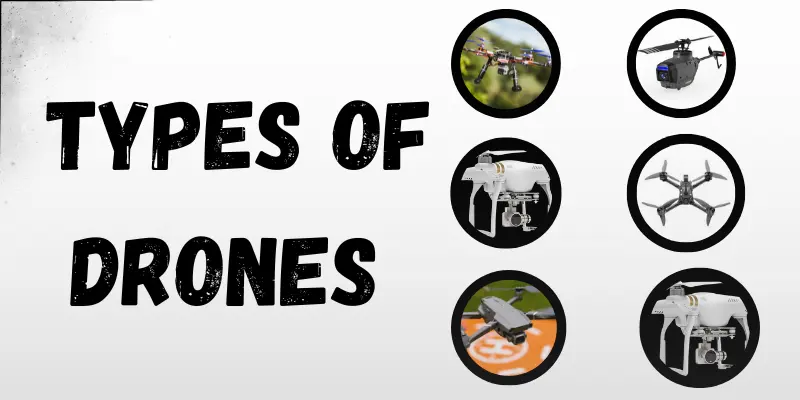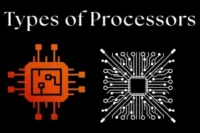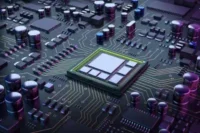11 Different Types of Drones
Published: 4 Aug 2025
Drones are now everywhere, used for everything from package delivery to aerial photography. Whether you’re a beginner, a hobbyist, or intend to use drones for business, it’s critical to understand the various types. Each drone has a unique purpose, features, and price. This guide will teach you what a drone is, the different types of drones, how to select the right one, and common mistakes to avoid when purchasing one.
What is a Drone?
A drone is a flying device that doesn’t require a human pilot on board. It’s also known as an Unmanned Aerial Vehicle (UAV). Drones can be controlled remotely or fly autonomously using software and sensors.
They come in all shapes and sizes. Some are small enough to fit in your hand, while others are large military machines. Drones are used in many fields, including photography, agriculture, delivery, surveillance, and entertainment.

Types of Drones
There are many types of drones, but they are typically categorized by design, size, or intended purpose. Here are the main ones:
1. Multi-Rotor Drones
The most popular type is the multi-rotor drone, which is commonly used for aerial photography and video. Quadcopters are typically made up of four rotors. These drones are simple to fly and remain stable in the air. However, they have shorter flight times and lower speeds than other types.
2. Fixed-Wing Drones
Fixed-wing drones resemble small airplanes and use wings to maintain their flight. They’re ideal for covering large areas and flying long distances. Drones are widely used for mapping, agriculture, and surveillance. They require a runway or launcher for takeoff and landing.
3. Single-Rotor Drones
Single-rotor drones have a single large rotor on top, similar to helicopters. They are powerful and can carry heavy items, such as cameras or equipment. These drones usually fly longer than multi-rotor drones. However, they are more difficult to control and typically cost more.
4. Hybrid Drones (VTOL)
Hybrid drones can take off vertically like a helicopter before flying forward like a plane. This makes them suitable for a variety of tasks such as rescue missions, delivery, and inspection. They offer the advantages of both fixed-wing and rotor drones. However, their design is complex and often expensive.
5. Nano Drones
Nano drones are the tiniest type, small enough to fit in your palm. They are mostly used for indoor flying and fun. These drones are very affordable and easy to carry. But they have limited features and very short battery life.
6. Nano Drones
Mini drones are slightly larger than nano drones and ideal for beginners. They’re lightweight, easy to fly, and ideal for practice. Many of them include basic cameras and flight features. However, they are not suitable for professional use or outdoor flying in windy conditions.
7. Racing Drones
Racing drones are designed to travel quickly and turn sharply. They are used in drone racing competitions and can reach extremely high speeds. These drones are light and highly customizable. However, they are not intended for photography and are challenging to fly for beginners.
8. Camera Drones
Camera drones are designed to capture high-quality images and videos from the air. They often feature GPS, gimbal stabilization, and 4K cameras. These drones are popular with photographers, vloggers, and filmmakers. However, they are more expensive than ordinary drones.
9. GPS Drones
GPS drones use satellite systems to maintain their position and follow pre-set flight paths. They offer innovative features, such as “Return to Home” and follow-me mode. These drones are highly reliable and helpful for long-distance flights. However, they need a strong GPS signal to function properly.
10. Delivery Drones
These drones are designed to carry and deliver packages. Companies like Amazon are testing them for fast deliveries. They can carry light to medium-weight items over short distances. Delivery drones are still in development and face many legal and safety rules.
11. Military Drones
Armed forces use military drones for monitoring, mapping, and combat. They are large, technologically advanced, and can fly for extended periods without a pilot. These drones come with advanced sensors, cameras, and, in some cases, weapons. They are not open to the public and are used under strict supervision.
How to Choose the Right Drone
There are numerous options available when purchasing a drone. Here are some tips to help you make the right decision:
1. Know Your Purpose
Start by understanding why you need a drone. Are you using it for fun, photography, farming, or business? Your purpose will help you pick the right type with the right features.
2. Set a Budget
Drones are available in a variety of price ranges, from low-cost toy drones to high-end professional models. Before you begin your search, decide how much money you want to spend.
3. Check the Flight Time
Flight time refers to how long the drone can stay in the air on a full charge. Look for drones with at least 15-30 minutes of flight time, particularly for outdoor or camera applications.
4. Consider the Camera Quality
If you’re buying a drone for video or photography, check the camera specifications. Select a drone with a resolution of at least 1080p or 4K for clear and sharp results.
5. Look for GPS and Stability Features
GPS helps the drone fly steadily and return safely to you. This is particularly useful for beginners, making flying easier.
6. Check the Control Range
The control range indicates the maximum distance the drone can fly without losing signal. Ensure the range meets your needs, especially if you’re using it for surveying or filming.
7. Pick a Drone That’s Easy to Fly
If you’re new to drones, consider choosing one with beginner-friendly features like auto-hover and one-key takeoff. This makes learning easier and avoids crashes.
8. Think About Portability
If you travel a lot, pick a drone that folds or comes with a carrying case. Lightweight and compact drones are easier to take anywhere.
9. Check Spare Parts Availability
Drones may require repairs, particularly to their propellers or batteries. Choose a model with easy access to spare parts and customer support.
10. Read Reviews and Watch Videos
Always check what other users say about the drone. Honest reviews and YouTube demos help you understand real-world performance before you buy.
Common Mistakes to Avoid When Buying a Drone
1. Buying the Most Expensive Drone First: A high price doesn’t always mean it’s the best for you. Start with a mid-range drone.
2. Ignoring Local Drone Laws: Always check your country’s drone rules. You might need a license or registration.
3. Not Reading Reviews: User reviews and expert opinions can save you from making a bad choice.
4. Forgetting About Accessories: You may need extra batteries, propellers, or a carrying case. Check what’s included.
5. Buying Without Practicing: Don’t buy a complex drone unless you’ve practiced with a basic one.
6. Overlooking Weather Limits: Not all drones can handle wind or rain. Always check the weather before flying.
Conclusion
Drones are exciting and valuable tools in today’s world. From recreational flying to serious work, there is a drone for everyone. Before purchasing, understand the various types, determine what you require, and avoid common mistakes. Whether you’re flying for fun or filming a movie from above, the right drone makes all the difference.
Frequently Asked Questions [FAQs]
Have questions about drones? Here are some of the most frequently asked questions to help you better understand the topic:
Drones are typically classified into four main types: single-rotor, multi-rotor, fixed-wing, and hybrid VTOL (Vertical Takeoff and Landing) drones. Each type serves a distinct operational purpose, ranging from precision mapping and surveillance to large-scale land mapping and industrial inspections.
The main types include multi-rotor, fixed-wing, single-rotor, hybrid (VTOL), nano, mini, camera, racing, GPS, delivery, and military drones. Each type is designed for different uses, such as photography, racing, or delivery.
Mini drones or camera drones with beginner modes are ideal for inexperienced users. They are simple to fly, inexpensive, and frequently equipped with auto-hover and return-home features.
GPS drones use satellite navigation to provide stable flight, route planning, and return-to-home capabilities. Regular drones rely solely on manual control and are less stable.
Most drones are not waterproof. Flying in rain or wet conditions can damage the aircraft, so always check the weather before taking off.

- Be Respectful
- Stay Relevant
- Stay Positive
- True Feedback
- Encourage Discussion
- Avoid Spamming
- No Fake News
- Don't Copy-Paste
- No Personal Attacks

- Be Respectful
- Stay Relevant
- Stay Positive
- True Feedback
- Encourage Discussion
- Avoid Spamming
- No Fake News
- Don't Copy-Paste
- No Personal Attacks





